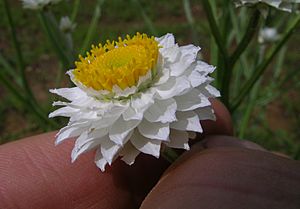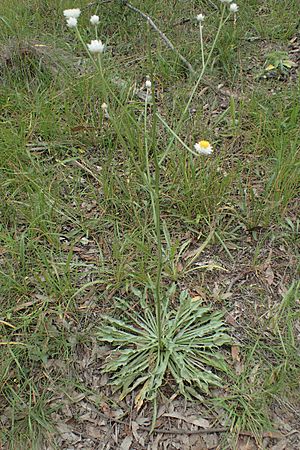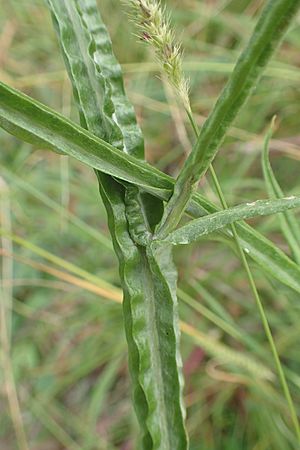Winged everlasting facts for kids
Quick facts for kids Winged everlasting |
|
|---|---|
 |
|
| Scientific classification | |
| Genus: |
Ammobium
|
| Species: |
alatum
|
| Synonyms | |
|
|
The Ammobium alatum, also known as the winged everlasting, is a type of plant in the daisy family. It's a perennial herb, meaning it lives for more than two years. You can find it in south-eastern Australia, where it grows naturally and has also spread to new areas.
This plant is easy to spot because of its special features. It has stems that look like they have "wings" on them. Most of its leaves grow near the bottom of the plant. Its flowers are bright yellow and are surrounded by papery white parts that look like petals.
Contents
What Does the Winged Everlasting Look Like?
The winged everlasting is a herb that usually grows to be about 60 to 100 centimeters (about 2 to 3 feet) tall. Its stems are often branched and covered in soft, woolly hairs. These stems have noticeable "wings" along their length.
Most of the plant's leaves are found at its base. These leaves are shaped like narrow eggs or triangles. They are typically 40 to 60 millimeters long and 10 to 15 millimeters wide. They grow on a stalk called a petiole, which can be 70 to 100 millimeters long. The stems also have a few smaller, sessile leaves that are like bracts.
The Flowers of the Winged Everlasting
The flowers of the winged everlasting are 10 to 20 millimeters wide. They have bright yellow florets, which are tiny individual flowers. These florets get darker as they get older. Each floret has a corolla (the part that looks like a petal) about 5 millimeters long.
The yellow florets are surrounded by papery, white parts called involucral bracts. These bracts are 5 to 10 millimeters long and have jagged edges. The plant mainly blooms from November to April. After flowering, it produces small, dark brown seeds called cypselas. These seeds are wrinkled and have a small bristle, or awn, up to 1 millimeter long.
Where Does the Winged Everlasting Grow?
The winged everlasting often grows in places where the land has been disturbed. You might see it on roadsides or in farm fields. Sometimes, its seeds are carried by rivers to new areas, and it can grow on riverbanks.
This plant is native to certain parts of Australia. It has been found in eucalypt forests and on rocky cliffs in northern New South Wales. It also grows on riverbanks in the upper Snowy River in Victoria, and in the Northern Tablelands and North West Slopes of New South Wales. You can also find it in south-east Queensland.
In 1804, a botanist named Robert Brown found many of these plants growing near the shores of Port Hunter (also known as the Coal River) in New South Wales. The winged everlasting has also spread and become naturalised in other areas. These include South Australia, the Australian Capital Territory, and Tasmania. It has also spread to places in New South Wales where it didn't originally grow.
How Did the Winged Everlasting Get Its Name?
The plant's scientific name, Ammobium alatum, and its genus, Ammobium, were first described in 1824. This was done by a botanist named Robert Brown in a publication called Curtis Botanical Magazine.
The name Ammobium comes from two Greek words: ammos, which means "sand," and bios, which means "life." This name describes how the plant often grows in sandy areas. The second part of the name, alatum, comes from the Latin word alatus, meaning "winged." This refers to the plant's unique winged stems.
See also
 In Spanish: Ammobium para niños
In Spanish: Ammobium para niños



